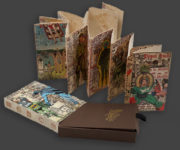
layered acrylic ink and varnish on amate paper
8.5 x 94 inches
edition of 12
Enrique Chagoya’s 2021 codex editions with Magnolia Editions take the artist’s signature collage technique — what he describes as “a hybrid contemporary genesis narrating multiple cultural collisions” – to kaleidoscopic new heights. Printed on traditional amate paper using layered UV-cured ink, Chagoya’s codices take an iconoclastic and highly comic approach to historical narratives of colonialism and conquest – and to the ponderous critical theory that often sandbags our understanding of complex events, imagery, and ideas. “Ultimately,” says Chagoya, “it’s about humor – I hope people will see themselves in the mirror.”
Chagoya’s El Popol Vuh de la Abuelita del Ahuizote/The Community Book of King Ahuizote’s Granny (2021) is based on an ancient Mayan codex now held in Madrid (one of only four pre-Columbian Mayan books that survived the war of conquest waged by Mexico). “Popol Vuh” is Mayan for the sacred book of the Mayan Genesis, translating as the Community Book or the Book of the People. Chagoya’s codex also incorporates imagery from codices painted by Aztec artists like Fernando de Alba Ixtlixochitl (Christianized name) immediately after the entirety of Aztec books and the main library in Texcoco were burned to ashes by Spanish Catholic priests and soldiers in 1521. Not a single pre-Columbian Aztec book survived the destruction – only a few Aztec books, painted immediately after, still remain.
The Popol Vuh codex depicts Aztec King Nezahualcoyotl (or Neza), who built the great library in Texcoco; notably opposed to human sacrifice, King Neza was an architect and a poet, organizing poetry and song festivals until his death in 1472. The work’s title also references Aztec King Ahuizote (Huey Tlatuani Ahizotl or Nahuatl for Great Ruler Ahuizotl), who expanded the Aztec/Nahua/Mexica empire in the late 1400s: Ahuizote was the uncle of king Moctezuma and the father of the last Aztec emperor, Cuauhtemoc who died defending Tenochtitlan (now Mexico City) against the Spanish Conquistadors. Four centuries later, at the turn of the 1900s, just before the Mexican revolution, satirical newspapers critiquing the dictatorship of President Porfirio Díaz were published under the names El Ahuizote (censored by the government) and later, El Hijo del Ahizote (“The Son of Ahuizote,” also censored). “There was never a Granny of the Ahuizote,” explains Chagoya, “so here it is!”
-Nick Stone
show prices
Prices and availability are subject to change without notice.The copyright of all art images belongs to the individual artists and Magnolia Editions, Inc.
©2003-2025 Magnolia Editions, Inc. All rights reserved. contact us


